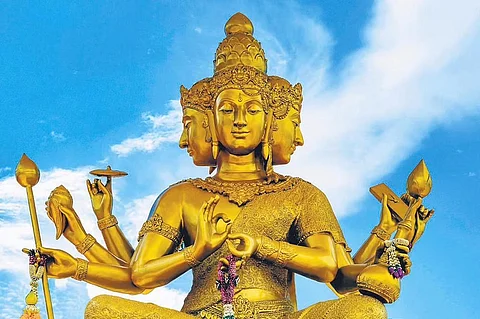

The Vedas believe in a formless Supreme God. It is difficult for an average devotee to understand and imagine a formless God. So, a concept of God with form—Ishvara—developed. This concept further developed into a trinity of gods; Brahma—the creator, Vishnu—the preserver, and Shiva—the destroyer.
The most important function of Brahma is creating the universe. One of the popular creation myths says that the universe is created, destroyed and then recreated in an endless series of cycles.
At the dawn of Brahma’s day, a hum of Om starts in the ocean of milk on which Vishnu is resting in celestial sleep. A lotus grows out of his navel from which emerges Brahma. Brahma stretches the three petals of the lotus into earth, sky and heaven. He also creates all life on earth. Some versions say that Brahma is swayambhu (self-born) or that he hatched from the hiranyagarbha (golden cosmic egg) that floated on the primal waters.
The universe endures for the length of Brahma’s day which is 4.32 billion earth years. At the end of the day, the universe is destroyed. This is called pralaya. Brahma rests for a night which is as long as his day. Then he recreates the world. This repeats every day for the entire life span of Brahma which is hundred Brahma years or 311,040 billion earth years. After the death of Brahma, a hundred Brahma years must elapse before a new Brahma is born and the cycle repeats itself.
Brahma is said to be the source of all the knowledge that exists in this world. He has four faces, one pointing in each of the major directions. His vehicle is swan which is said to have the power to separate milk from water. Unlike Vishnu or Shiva, Brahma carries no weapons. Instead, he holds in his hands a lotus flower, symbolising the lotus from which Brahma himself evolved, a kamandala (water pot), signifying water’s role in creating life, the Vedas, representing knowledge and a string of rosary beads, symbolising the cycle of time.
Despite Brahma’s important role in creation, he is much less popular today than the other two gods of the trinity. There are very few temples devoted to Brahma eg, Pushkar (Rajasthan), Tirunavaya (Kerala), Bangkok (Thailand), Prambanan (Java) and Angkor Vat (Cambodia). While there are mythological stories that say it is due to a curse, perhaps some reason is to be found in human psychology. It is possible that our sense of gratitude for the act of creation in the past is not as strong as the hope of advancement to be gained by worshipping Vishnu or the fear of destruction at the hands of Shiva!